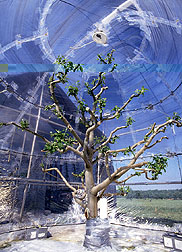This page has been archived and is being provided for reference purposes only. The page is no longer being updated, and therefore, links on the page may be invalid.
Fire Blight Goes Under WrapsBy Doris StanleyJune 23,1997 The bacterium that causes fire blight in apples and other fruits doesn’t linger in a tree’s older vascular system in numbers sufficient to cause disease, scientists with USDA’s Agricultural Research Service say. To make this discovery, scientists at the agency’s Appalachian Fruit Research Laboratory in Kearneysville, W. Va., built two aseptic, whole-tree arborspheres—a kind of plastic growth chamber—over four severely blighted, 12-year-old Rome Beauty apple trees. First, the scientists heavily pruned the trees in the fall to remove any cankers or damaged bark that might house bacteria. Later, they applied dormant insecticidal oil to kill any insect eggs, and used a copper compound on two trees to eliminate any surface bacteria. Then, in April, they created the arborspheres, each with an untreated and a copper- treated tree. Made with clear plastic-and-pipe frames, the structures were equipped with air supply systems and filters to block outside bacteria from entering. After three months in the arborspheres, no bacteria were detected on petri dishes left in the structures for four days. Surrounding trees not protected by a sterile atmosphere were heavily infected with fire blight. Results from this research can help growers. Extremely heavy pruning causes an overabundance of new, tender shoots that are more susceptible to fire blight infection. Therefore, when trees are dormant, growers should remove only the blighted shoots and large cankers. Proper pruning should also ensure adequate light penetration into the tree canopy to maintain good tree growth. More details on this story appear in the June issue of Agricultural Research, the monthly magazine of the Agricultural Research Service. The story is available in HTML format on the World Wide Web at: /is/AR/archive/jun97/fireblight0697.htm Scientific contact: Tom van der Zwet, USDA-ARS, Appalachian Fruit Research Laboratory, Kearneysville, W.Va., phone 304-725-3551, fax 304-728-2340. |

